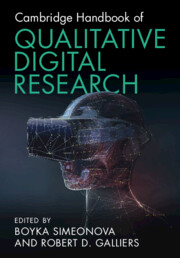Book contents
- Cambridge Handbook of Qualitative Digital Research
- Cambridge Handbook of Qualitative Digital Research
- Copyright page
- Contents
- Figures
- Tables
- Contributors
- Preface
- Part I Philosophical, Epistemological and Theoretical Considerations
- Part II Methodological Considerations
- Part III Illustrative Examples and Emergent Issues
- Chapter 13 Observing Artifacts
- Chapter 14 Algorithms as Co-Researchers
- Chapter 15 Sensemaking about HRV Data of High-Performing Individuals
- Chapter 16 The Rich Facets of Digital Trace Data
- Chapter 17 Balancing the Momentum of Datafication with Qualitative Researchers as Design Thinkers
- Chapter 18 What Data Sharing in Government Tells Us about the Digitalization of Government Services
- Index
- References
Chapter 16 - The Rich Facets of Digital Trace Data
from Part III - Illustrative Examples and Emergent Issues
Published online by Cambridge University Press: 08 June 2023
- Cambridge Handbook of Qualitative Digital Research
- Cambridge Handbook of Qualitative Digital Research
- Copyright page
- Contents
- Figures
- Tables
- Contributors
- Preface
- Part I Philosophical, Epistemological and Theoretical Considerations
- Part II Methodological Considerations
- Part III Illustrative Examples and Emergent Issues
- Chapter 13 Observing Artifacts
- Chapter 14 Algorithms as Co-Researchers
- Chapter 15 Sensemaking about HRV Data of High-Performing Individuals
- Chapter 16 The Rich Facets of Digital Trace Data
- Chapter 17 Balancing the Momentum of Datafication with Qualitative Researchers as Design Thinkers
- Chapter 18 What Data Sharing in Government Tells Us about the Digitalization of Government Services
- Index
- References
Summary
Increasing digitalization means that many of our daily interactions happen within digital environments where they leave digital footprints in the form of trace data. Such digital trace data is often thought to generate insights by virtue of its immense scale. This focus on ‘big data’ tends to overlook the richness and complex characteristics of digital traces that opens new vistas for a multitude of computational analyses that generate new and high-resolution insights to digital environments. As such, paying attention to the characteristics of trace data allows for deep investigations of social-technical interactions in unprecedented detail.
This chapter describes the process of digital trace analysis through four analytical activities aimed at identifying units of analysis, extracting categories, validating patterns and conceptualizing findings from digital trace data. It then shows how analytical activities can be applied to a given digital trace dataset to derive three ‘facets’ that each provide rich conceptualizations of social interaction with technology. It explains each facet and outlines ways to implement digital trace analyses that focus on facets relating to relations (network analysis), processes (sequence analysis) or semantics (text analysis).
Keywords
- Type
- Chapter
- Information
- Cambridge Handbook of Qualitative Digital Research , pp. 247 - 267Publisher: Cambridge University PressPrint publication year: 2023



